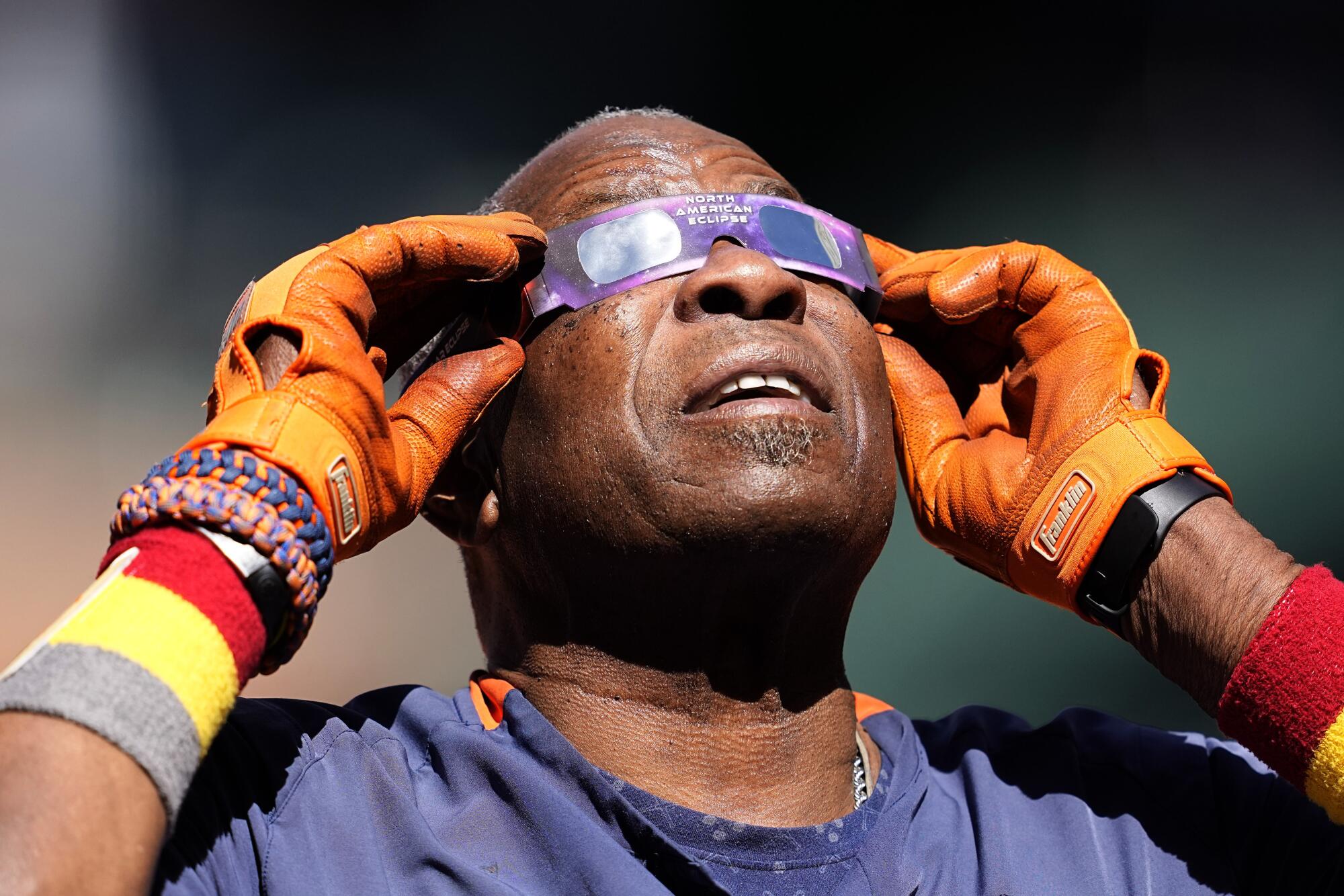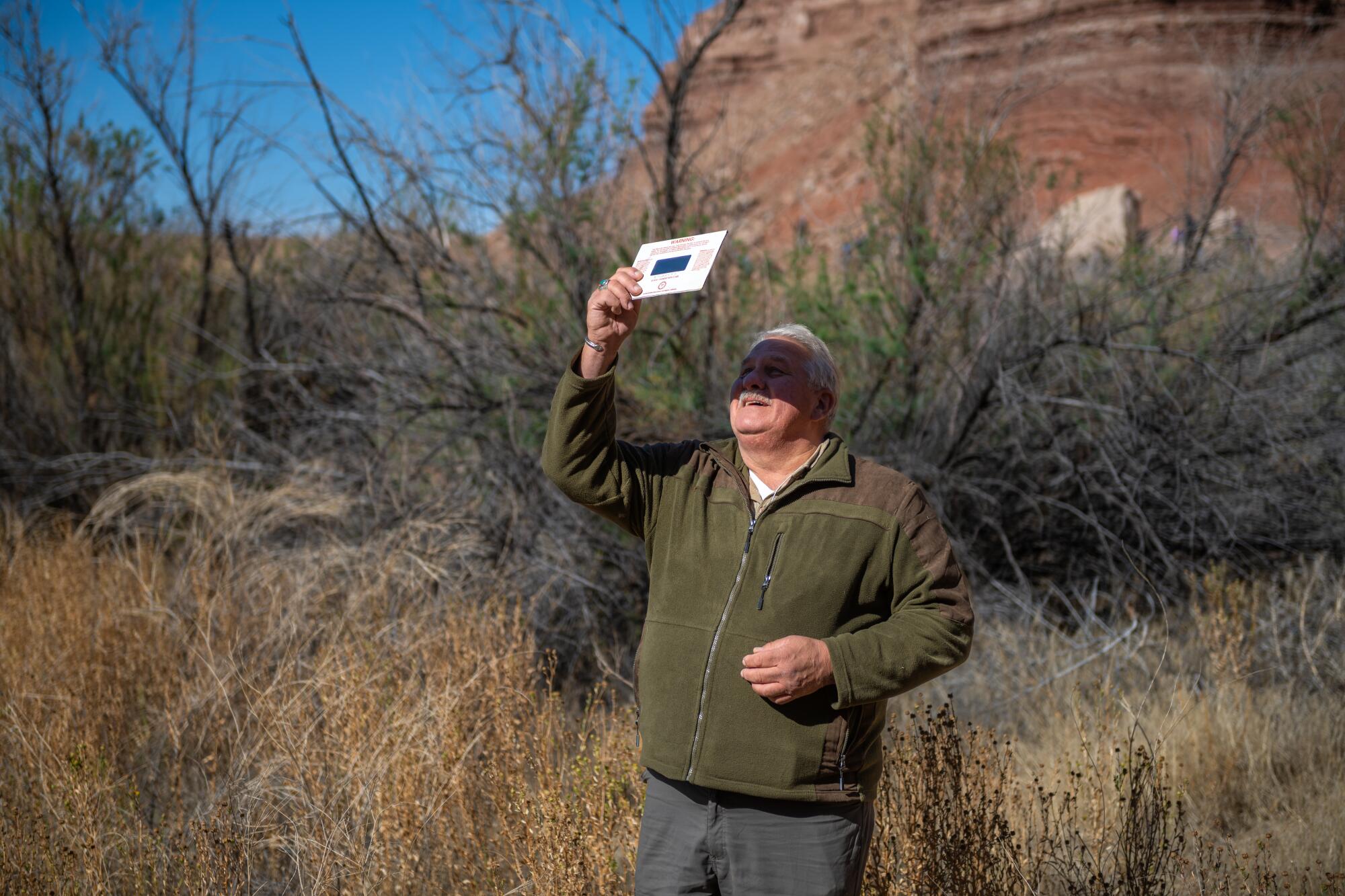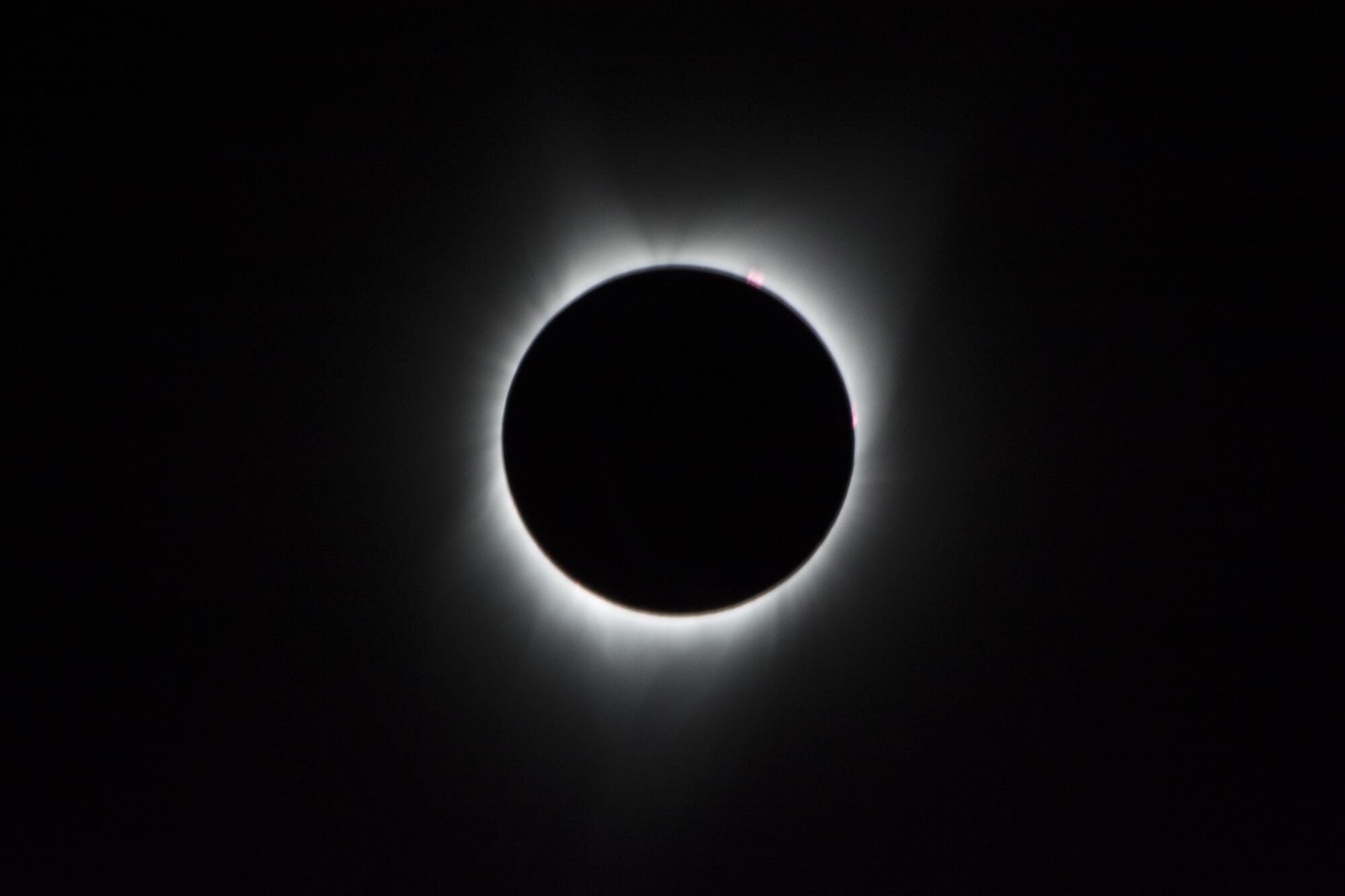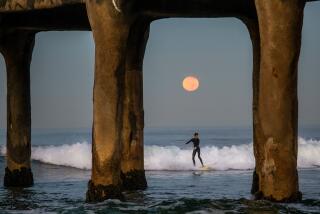A partial solar eclipse as it will appear in Los Angeles from the southeast April 8.
- Share via
While a narrow strip of North America celebrates the arrival of a rare total solar eclipse April 8 — when midday darkness will be cast on a sliver of states, including Texas, Illinois, Ohio and New York — there won’t be any “totality” in Los Angeles.
Still, if the skies remain cloud-free, California will enjoy an impressive partial eclipse that will feature the moon taking a bite out of the late-morning sun.
In Los Angeles, about half of the sun will be visibly covered by the moon, and in San Francisco, one-third will be. The northernmost parts of the state will see the smallest amount of the eclipse, while cities to the south will experience more. In Crescent City, in coastal Del Norte County, about 25% of the sun will be eclipsed; in Holtville, near the Mexican border in Imperial County, up to 58% of the sun will be blocked.
It’ll be the last partial solar eclipse for L.A. and San Francisco until 2029.
The event has generated considerable buzz, as it will be the last total solar eclipse seen from the contiguous United States until 2044. The last one was in 2017, and before that, in 1979. Last October’s “ring of fire” solar eclipse was not total but “annular,” in which the moon was a bit farther away from Earth and short of completely blotting out the sun, thus leaving a glowing ring around it.
Cities in a narrow, 115-mile “path of totality” — where the moon completely blocks the sun’s visible surface — include Mazatlán, Mexico; Dallas; Indianapolis; Cleveland; Niagara Falls, N.Y.; and Sherbrooke, Canada. An estimated 31.5 million live in the path of totality, and about 200 million others are within a few hours’ drive. Far more people live in or near the eclipse’s path compared with those in 2017 and 1979.
What makes this solar eclipse particularly notable is that the entire contiguous U.S., as well as parts of Alaska and Hawaii, will be able to view at least a partial eclipse, allowing for a national experience.
But there’s a risk of heartbreak for eclipse aficionados if clouds roll in. Overcast skies will still darken in the path of totality, but “it’s obviously not as much fun as observing a solar eclipse in a cloud-free sky,” said Jean-Luc Margot, a UCLA professor of planetary astronomy.
In Los Angeles, the partial solar eclipse will start at 10:06 a.m., and a substantial bite of the sun will be obvious by 10:39 a.m., peaking at 11:12 a.m. By 12:22 p.m., it will be over, according to the Griffith Observatory.
You will be able to see a small, little bite-sized chunk that the moon is taking out of the sun as it blocks some of its light.
— Dakotah Tyler, UCLA astrophysics doctoral student
NASA offers an eclipse explorer map, at go.nasa.gov/EclipseExplorer, with data for U.S. cities.
“You will be able to see a small, little, bite-sized chunk that the moon is taking out of the sun as it blocks some of its light,” said Dakotah Tyler, an astrophysics doctoral student at UCLA who also makes science videos on social media. “So that’s still a really cool thing to see, even if you’re not in the path of totality.”
You should not look at the sun directly during any phase of a partial solar eclipse. And relying only on regular sunglasses, smoked glass or polarizing filters is also not safe.
“It is very dangerous to look at the partially eclipsed sun directly with your own eyes,” said Ed Krupp, the longtime director of the Griffith Observatory. “You’re tempted to do it, but it will burn the retinas permanently and cause permanent blindness.”

In one documented case, a young woman who looked at the 2017 solar eclipse for 20 seconds without eye protection suffered permanent eye damage with no known treatment, according to the New York Eye and Ear Infirmary of Mount Sinai. Within hours, her eyesight became blurry and she could see only the color black. Doctors found she had crescent-shaped retinal damage, which was the “shape of the visible portion of the sun during the partial solar eclipse in New York City,” the facility said.
“You need eye protection. That’s crucial,” Margot said.
People should obtain eclipse glasses or handheld sun filters, but buy them from reputable retailers. NASA says safe solar viewers should comply with the ISO 12312-2 international standard, adopted in 2015. Those made with this standard can be used indefinitely as long as they aren’t damaged, the American Astronomical Society says, so those left over from the 2017 eclipse are safe to use if they aren’t torn, scratched or punctured, or the filters aren’t coming loose from the cardboard of plastic frames.
Beware, though: Some eclipse glasses are labeled ISO-compliant but haven’t been properly tested, the society said. “Don’t pick up your eclipse glasses on some street corner. People make fake ones now, and it’s quite problematic,” Krupp said. The American Astronomical Society posts a list of North American manufacturers and importers whose products are safe if used properly.

Some experts also warn against staring at the eclipse for minutes on end, even with proper eye protection. Krupp suggests looking up for just a moment, to see the progress, and then waiting 10 minutes or so before seeing how it looks again.
“Just because you have a filter, or eclipse glasses, doesn’t mean that it’s safe ... to keep staring and staring. That’s the last thing you want to do,” Krupp said.
Another way to monitor the eclipse’s progression is through a pinhole camera, which can be made by poking a hole in a piece of aluminum foil or paper with a safety pin, paper clip or pencil, and projecting the image of the sun onto the ground. Holding up a colander can also project the partial eclipse onto the ground, as can looking at sunlight dappling through a tree’s leaves, or through your fingers aligned perpendicularly.
People using binoculars, camera lenses and telescopes need to mount proper solar filters on the outermost lenses receiving light, filtering the powerful rays before they enter the device. Otherwise, the sunlight will be concentrated, and instant, severe eye injury can occur, NASA warns.
For those interested in taking photos of the eclipse with their smartphone, Krupp suggested shooting wide-angle views. The sun will appear pretty small, “but you’ve got the landscape around there” — similar to how people take photographs of sunrises and sunsets.
There will be eclipse viewing parties across California, including at the California Science Center in South L.A., Caltech and Cal State L.A. (An event at the Mt. Wilson Observatory was canceled.) A number of public libraries across Los Angeles County also will hold viewing parties, and eclipse glasses will be available as long as supplies last.
One notable place that won’t host an in-person watch party is Griffith Observatory. Instead, it will broadcast the total solar eclipse live from Belton, Texas. The Griffith Observatory Foundation is leading a viewing trip there as well as to Mazatlán, Mexico, where Krupp will be.
A big worry for eclipse chasers seeking to be in the path of totality is the weather. Unlike the Aug. 21, 2017, total solar eclipse, which was blessed with sunny skies for many, this April could be a different story.
“I’m calling this eclipse — April 8, 2024 — the ‘heartbreaker’ because we know the saying: ‘April showers bring May flowers.’ So dodging the clouds is going to be anything but a trivial task for this particular eclipse,” Jeremy Veldman, president of the Memphis Astronomical Society, said in a YouTube video that covered 45 years of weather satellite photos for previous April 8 dates, as compiled by the Cooperative Institute for Meteorological Satellite Studies.
A detailed analysis of past climate conditions for April, between 2000 and 2020, posted on the website Eclipsophile, said the probability of cloudiness increases the farther north you go.
But climate averages are useful only if you’re planning years in advance. There have been times on April 8, Veldman said, such as in 2019, where “no matter where you go, there’s the likelihood you’re gonna be dodging clouds,” with the exception of southern Texas. But sometimes, like on April 8, 1994, southern Texas was cloudy but other areas farther north were largely clear, even New York.
The Eclipsophile analysis said that now is the time to start looking at long- and short-range forecasts.
The call about where to go is mixed. Some have well-laid plans and say they’ll stay put, no matter what. Other die-hard eclipse chasers may have multiple contingencies “so that they can change based on the weather,” NASA astrophysicist Kelly Korreck said at a briefing in January.
But deciding to move locations too late could leave you stuck in traffic. “Even interstates will come to a halt when the eclipse is imminent,” the Eclipsophile analysis said.
For those lucky enough to experience totality and who are positioned along the eclipse’s center line, it’ll be a relatively long event, generally 3½ to 4 minutes, depending on location. By contrast, the longest duration of the 2017 total solar eclipse, near Carbondale, Ill., was about 2 minutes, 40 seconds.
Veteran eclipse watchers say those in the path of totality can expect a transcendental experience. The last moment of sunlight that’s blocked out by the moon “produces a bright, bright spot on the dark disk of the sun,” Krupp said, referred to as a “diamond ring.”
If skies are clear, you might notice a “distinct column of the shadow of the moon — this cylindrical shadow column — moving toward you,” said Tim Thompson, the science director for Mt. Wilson Observatory. Once you’re in the shadow, the temperature can drop; during his total solar eclipse experience in Idaho in 2017, the temperature dropped by 20 degrees.
Then, a moment later, the moon will completely block the sun’s surface.
“It’s like somebody threw a switch. The sun is completely blocked by the moon. The darkness of the eclipsed sun is darker than the sky around it,” Krupp said. “It seems like the deepest black that you’ve ever seen, particularly in contrast with the rest of the sky — which has grown dark, but not nighttime dark.”
Animals may react strangely, thinking it’s nighttime, and it can feel like “you’ve got this wraparound sunrise-sunset,” Krupp said. “You’re looking out in every direction from where you are in the middle of the shadow.”
Added Thompson: “It’s that sunrise-sunset effect all along the horizon. You can’t see that kind of thing, ever, except during a total eclipse.”
For those in the zone of totality, that’s the only time it’s safe to take off eclipse glasses and watch with the naked eye, NASA says. People may be able to see the sun’s corona, the outer solar atmosphere, that’s superheated to millions of degrees — hotter than the surface of the sun, Tyler said.
“The corona is a very bright white, and very obvious. And you never see anything like that unless it’s a total eclipse,” Thompson said. “The contrast between that and the moon is so extreme — the moon becomes the blackest thing you’ve ever seen. ... It’s just like a hole punched in the universe.”

Krupp described the corona as a “pearly whitish halo of light around the sun, but has streamers going in various directions.” Another feature that can be seen are flame-like structures called prominences on the edge of the sun, showing up in contrast to the white light of the corona. They are coming out of the chromosphere, “which is shining with the red light of hydrogen at a particular temperature. And that looks sort of like a little arc of red, just depending on where you get it. It hugs the dark disk of the sun,” Krupp said.
Thompson suggested those attending their first total solar eclipse not bother with special viewing equipment during totality. “If you’ve never done it before, then you don’t want to be distracted by anything,” Thompson said. “Don’t take telescopes, don’t try to photograph it. Maybe hold up your cellphone camera and take a click or something. ... But it’s all about being there and being part of the experience.”
It’s a marvel that solar eclipses happen in such perfect formation between Earth, the moon and the sun.
There’s “this amazing cosmic coincidence that the size of the moon and the size of the sun — in an angular sense — are about the same,” Margot said. “Even though the sun is 400 times larger than the moon ... it also happens to be 400 times further away.”
Those in the path of totality should keep an eye on the time — perhaps using a timer or alarm — to know when to put their eclipse glasses back on.
More to Read
Sign up for Essential California
The most important California stories and recommendations in your inbox every morning.
You may occasionally receive promotional content from the Los Angeles Times.













